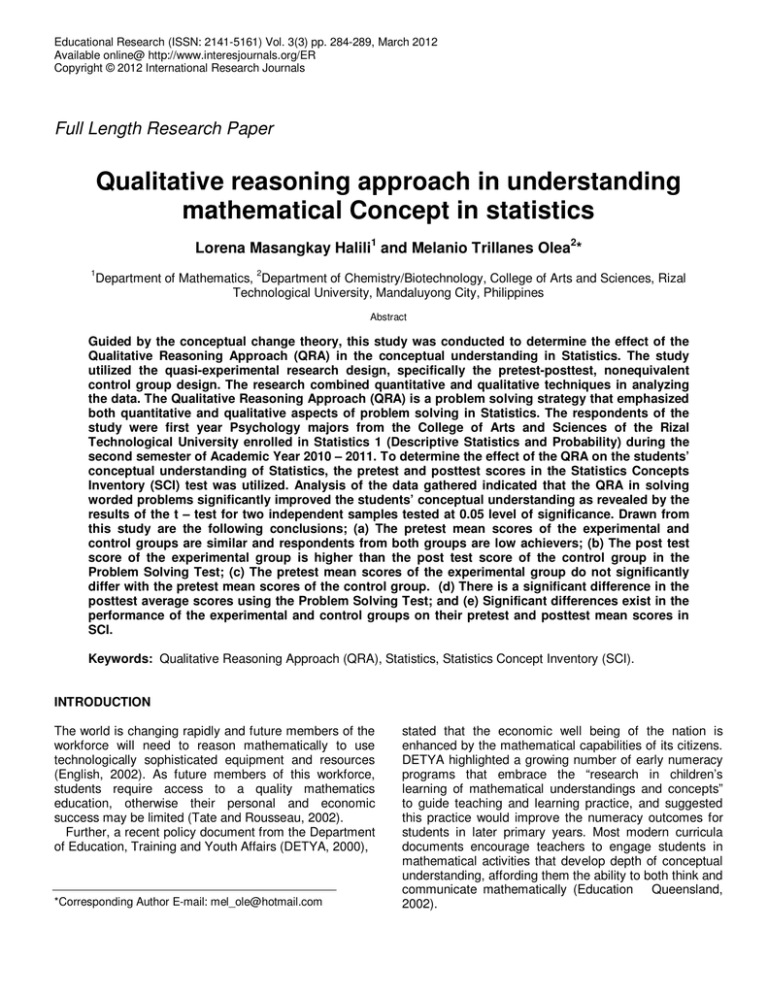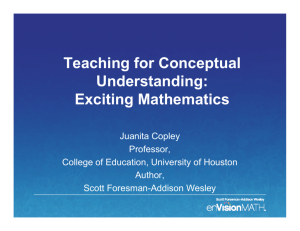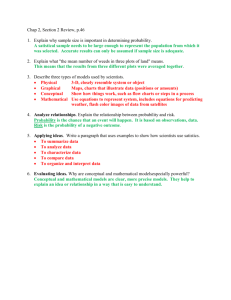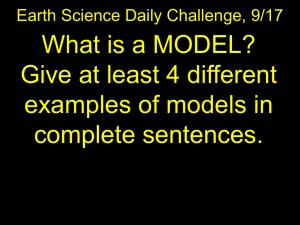Document 14093431
advertisement

Educational Research (ISSN: 2141-5161) Vol. 3(3) pp. 284-289, March 2012 Available online@ http://www.interesjournals.org/ER Copyright © 2012 International Research Journals Full Length Research Paper Qualitative reasoning approach in understanding mathematical Concept in statistics Lorena Masangkay Halili1 and Melanio Trillanes Olea2* 1 Department of Mathematics, 2Department of Chemistry/Biotechnology, College of Arts and Sciences, Rizal Technological University, Mandaluyong City, Philippines Abstract Guided by the conceptual change theory, this study was conducted to determine the effect of the Qualitative Reasoning Approach (QRA) in the conceptual understanding in Statistics. The study utilized the quasi-experimental research design, specifically the pretest-posttest, nonequivalent control group design. The research combined quantitative and qualitative techniques in analyzing the data. The Qualitative Reasoning Approach (QRA) is a problem solving strategy that emphasized both quantitative and qualitative aspects of problem solving in Statistics. The respondents of the study were first year Psychology majors from the College of Arts and Sciences of the Rizal Technological University enrolled in Statistics 1 (Descriptive Statistics and Probability) during the second semester of Academic Year 2010 – 2011. To determine the effect of the QRA on the students’ conceptual understanding of Statistics, the pretest and posttest scores in the Statistics Concepts Inventory (SCI) test was utilized. Analysis of the data gathered indicated that the QRA in solving worded problems significantly improved the students’ conceptual understanding as revealed by the results of the t – test for two independent samples tested at 0.05 level of significance. Drawn from this study are the following conclusions; (a) The pretest mean scores of the experimental and control groups are similar and respondents from both groups are low achievers; (b) The post test score of the experimental group is higher than the post test score of the control group in the Problem Solving Test; (c) The pretest mean scores of the experimental group do not significantly differ with the pretest mean scores of the control group. (d) There is a significant difference in the posttest average scores using the Problem Solving Test; and (e) Significant differences exist in the performance of the experimental and control groups on their pretest and posttest mean scores in SCI. Keywords: Qualitative Reasoning Approach (QRA), Statistics, Statistics Concept Inventory (SCI). INTRODUCTION The world is changing rapidly and future members of the workforce will need to reason mathematically to use technologically sophisticated equipment and resources (English, 2002). As future members of this workforce, students require access to a quality mathematics education, otherwise their personal and economic success may be limited (Tate and Rousseau, 2002). Further, a recent policy document from the Department of Education, Training and Youth Affairs (DETYA, 2000), *Corresponding Author E-mail: mel_ole@hotmail.com stated that the economic well being of the nation is enhanced by the mathematical capabilities of its citizens. DETYA highlighted a growing number of early numeracy programs that embrace the “research in children’s learning of mathematical understandings and concepts” to guide teaching and learning practice, and suggested this practice would improve the numeracy outcomes for students in later primary years. Most modern curricula documents encourage teachers to engage students in mathematical activities that develop depth of conceptual understanding, affording them the ability to both think and communicate mathematically (Education Queensland, 2002). Halili and Olea 285 Thus, mathematics education must include key concepts and processes for a student to have the opportunity to be successful in the 21st century (English, 2002). Mathematics today is characterized by an explosive creativity, rapid expansion in its field of application, increasing use of abstract theories, and a tendency, towards unification in terms of set theory. Much of traditional mathematics is insufficient for many needs of modern technology. For this reason, the mathematics teaching – learning process should be strengthened to improve students’ achievement (Valdez, 2001). The continuing development of knowledge and learning is viewed as a cognitive activity involving the ongoing construction of mental representations of reality. This shows a shift in dominant educational philosophy in which learning has been equated primarily with the attainment of behavioral outcomes (Tenenbaum et al., 2001). Learning how to support one’s mathematical conclusions through the use of logical argumentations should augment or even replace the manipulation of symbols and algorithms in classrooms. Serious attention therefore needs to be paid to its pedagogic potential in all learning environments and context to establish a dynamic relationship between how teachers teach and how children learn. Effective teachers recognize that the decisions they make shape students’ mathematical dispositions and can create rich settings for learning. Selecting and using suitable curricular materials, using appropriate instructional tools and techniques, and engaging in reflective practice and continuous self-improvement are actions good teachers take everyday. Teachers’ daily planning decisions influence directly the mathematical achievement of students (Shrum, 2005). Therefore, teachers must always bear in mind that they want to inculcate in students the value of mathematics and guide them to become good problem solvers and to learn to reason and communicate mathematically. A more challenging endeavor then on the part of teachers is to create a classroom that focuses on students’ thinking about real life circumstances and situations that stimulate both learners and teachers. Students must be given opportunities to engage in problem – solving tasks and provide venues to verbalize own ideas for the class members to affirm or reject what is being shared thus, making classroom discussions rich with students own generalizations. It is essential in the field of education that teachers have the skill of analyzing the methods used to teach children and assess the goal of these methods to ensure that meaningful learning is occurring (Mayer, 2002; Snowman and Biehler, 2003). It then becomes the duty of the teacher to teach mathematics in a way to encourage the understanding of the required basic structure of mathematics. One way of achieving this is through a careful and thoughtful selection of appropriate teaching strategy that will help in promoting students’ ability to create meaning of mathematical concepts rather than passive reception of ideas (Adeleke, 2007). The main purpose of this study is to investigate the effect of the Qualitative Reasoning Approach (QRA) on students’ conceptual understanding of statistics in terms of Statistics Concepts Inventory (SCI) score. The study is based on the theoretical framework of theory of conceptual change. It posits that students learn when an existing conception that they already possess is challenged. Conceptual change theory is based on Jean Piaget’s ideas and writings on how students learn. Piaget used the idea of schemas to describe the mental skills that a student or a person possesses, and also defined two terms to describe how students process new information or ideas into their already existing schemas: assimilation and accommodation. Assimilation occurs when a student encounters a new phenomenon or idea and uses existing schemas to make sense of it. The new information is assimilated into the old schemas. However, if the students’ existing schemas cannot fully explain the new phenomenon, it creates a perturbation for the student. Then, a review of the phenomenon is initiated that may lead to an accommodation (Von Glasersfeld, 1997). During accommodation, a student must reorganize or replace his existing schemas to allow for understanding the new phenomenon. “Without such concepts it is impossible for the learner to ask a question about the (new) phenomenon, to know what would count as an answer to the question, or to distinguish relevant from irrelevant features of the phenomenon” (Posner et al., 1982). In one of the first articles published on conceptual change theory in science education, Posner et al. (1982) recommend the following teaching strategies for teaching toward conceptual change: (1) Develop lectures, demonstrations, problems, and labs that can be used to create cognitive conflict in students; (2) Organize instruction so that teachers can spend a substantial portion of their time in diagnosing errors in students’ thinking and identifying defensive moves used by students to resist accommodation; (3) Develop the kinds of strategies that teachers could include in their repertoire to deal with student errors and moves that interfere with accommodation; (4) Help students make sense of science content by representing content in multiple modes (e.g. verbal, mathematical, concrete-practical, pictorial), and by helping students translate from one mode of representation to another; and (5) Develop evaluation techniques to help the teacher track the process of conceptual change in students. Conceptual change theory has been a major theoretical framework for science education, especially physics in the last thirty years or so. It has only been transferred to other fields in a limited capacity. However there are a few recent studies in mathematics and statistics that have 286 Educ. Res. Independent Variables Dependent Variables Experimental group Exposed to QRA Students’ conceptual understanding Control group taught using the traditional method of teaching Figure 1. Research Paradigm used conceptual change theory successfully as their theoretical framework (Chance et al., 2004). In conceptual change, an existing conception is fundamentally changed or even replaced (Davis, 2001). Various studies in science education have shown that when students come to conceptual understanding of a topic through conceptual change instruction, their conceptual skills are much stronger because they understand how they come to their conceptual understanding (Vosniadou, 1994). Figure 1 illustrates the effect of QRA on students’ conceptual understanding and problem-solving performance in Statistics. The students’ conceptual understanding is the dependent variables and the QRA is the independent variable. In line with the research paradigm and the statement of the problem, the hypothesis that there is no significant difference between the performances of the two groups in the pretest mean scores in SCI was tested. Findings of this study may encourage students to improve their conceptual understanding of mathematics, mathematical reasoning, critical thinking and problem – solving skills which are necessary in their respective fields. This study will help statistics students achieve mathematical maturity in such a way that they can make mathematical connections. In understanding the concepts in statistics, students may appreciate its power and beauty as well as enjoy the course and change their mathematical preconceptions. RESEARCH METHODOLOGY Research Design The study utilized the quasi-experimental research design that approximates the conditions of the true experiment in a setting which does not allow the control and/or manipulation of all relevant variables. The quasi- experimental design is a form of experimental research used extensively in the social sciences and psychology and is characterized by methods of partial control based on a core identification of factors influencing both internal and external validity (Shuttleworth, 2008). Population Frame and Sampling Scheme From the population of students enrolled in Statistics 1 (Elementary Statistics and Probability), this study covered only two sections (blocks) ( 50 students per class) from the Bachelor of Science in Psychology, College of Arts and Sciences of the Rizal Technological University for the second semester of the academic year 2010 – 2011. Only 50% of the students enrolled in the two classes were utilized in this study. The sampling scheme used to determine the experimental and control groups was purposive sampling also known as judgmental sampling. Prior to the conduct of the study, the researcher asked the assistance of a psychologist to administer an IQ test to match the respondents in terms of their IQ level and only average students were included in this study. Research Instruments The study made use of the Statistics Concept Inventory (SCI). A concept inventory is a multiple choice cognitive assessment instrument designed to assess students’ conceptual understanding of a specific field or topic of science. Scores are often used as a pre-test versus posttest measure to assess students’ conceptual knowledge gain. The Statistics Concept Inventory (SCI) is a concept inventory similar to the Force Concept Inventory (FCI) and other concept inventories, the ultimate goal of which is to increase understanding and awareness of what, why, and how students learn. The SCI as a whole can be Halili and Olea 287 Table 1.Pretest Mean Scores of the Experimental and Control Groups in SCI Group Samples Mean Score Standard Deviation Experimental 25 5.04 1.99 Control 25 5.48 2.18 Table 2.Difference in the Pretest Mean Scores of the Experimental and Control Groups in SCI Groups Test Pretest Experimental mean stdev 5.04 1.99 Control mean stdev 5.48 2.18 said to measure the construct “statistics knowledge” or, more precisely, “conceptual understanding of statistics” (Allen, 2006). RESULTS The results of the study are shown in the following matrix for greater clarity and understanding of the data. As shown in Table 1 the results reveal that the average score of the control group is slightly higher than that of the experimental group with a difference of 0.44. This difference implies that both groups can perform in the same manner at the start of the study. The average score of both groups further revealed that they fall below the achievement level since they were not able to even reach the middle 50%. Since these are average pretest scores, these are valid since pretests are given at the start of the study to determine whether there were concepts that were already understood and to identify which concepts need to be emphasized in the lessons that will follow. Hence, most items were incorrectly answered by the respondents. It can be gleaned from Table 2 that the pretest average scores of the experimental and control groups are 5.04 and 5.48 respectively. As regards to their performance in relation to the mean, the control group is more heterogeneous as revealed by the group’s standard deviation of 2.18 compared to that of the experimental group at 1.99. Further, the table shows that the computed t – value using the t – test for independent samples is l– 0.75l, less than the tabular value of l– 2.0126l at .05 level of significance for a two – tailed test with 48 degrees of freedom. This indicates failure to reject the null hypothesis of no significant difference between the means of the two groups thus, the groups are equivalent. The results could be attributed to the method used in controlling certain variables such as IQ, age and gender. Computed t-value Critical t-value -0.75 -2.0126 Decision Accept H0 Remarks not significant This notion is supported by Fraenkel and Wallen (2006) who emphasized in his book that in conducting an experimental study, threats due to subject characteristics could be minimized or eliminated by controlling extraneous variables like age, gender and IQ. This way, the groups were made equivalent so as to establish the internal validity of the study. Reflected in Table 3 is the difference in the pretest and posttest mean scores of the experimental and control group in SCI. It can be noted in the above table that the computed t – value using the t – test for two independent samples is greater than the critical value that leads to the rejection of the null hypothesis of no significant difference. It follows that a significant difference exists between the performance of the groups in the pretest and posttest mean scores in SCI. The results further revealed that the overall mean score of the experimental group is higher than that of the control group that indicates a significant improvement in the respondents’ conceptual understanding which can be attributed to their exposure to the QRA since in the process they will have the opportunity to apply the different concepts that were previously learned. This result supports that of Gerace and Beatty (2005) for in their study, it was stated that at the end of the course, students are expected to understand and not just recall the ideas and skills they have gained in new contexts. DISCUSSION The concept of education has changed from the traditional subject-centered classroom to the more innovative learner-centered classroom. This transition therefore encourages teachers to create situations where students can be active, creative, and responsive to the physical world. This can be done by asking students to explore, justify, represent, discuss, use, describe, 288 Educ. Res. Table 3.Difference in the Performance of the Experimental and Control Groups on Pretest and Posttest Mean Scores in SCI Tests Pretest and Posttest Experimental mean stdev 6.96 1.65 Groups Control mean stdev 5.62 1.79 investigate, predict; in short, by being active in the learning process. The goal is for students to see that Mathematics is practical and used daily with the hopes of students acquiring a deeper appreciation for the subject. Teachers are also encouraged to become instruments in the development of higher order thinking skills (HOTS) through active involvement in learning mathematical content. Provision of methods of inquiry and application, ways of thinking and reasoning used in learning and doing all real mathematical activities must be made for students to experience active learning in the mathematics classroom. This viewpoint is also reflected in the new standards for mathematics instruction from the National Council of Teachers of Mathematics (2000, NCTM). The NCTM standards propose new expectations for what students should learn and about how this learning should occur. They mandate increase emphasis upon complex problem solving, higher level reasoning, and making connections across mathematical domains, and communication. In addition, they recommend decreased emphasis upon rote computation, routine problem solving, and overdependence upon the teacher or text for explaining and evaluating concepts and procedures. In short, instruction should de-emphasize the transmission of factual or otherwise incontestable information from teachers to students and should encourage the active involvement of students in discussing ideas, making convincing arguments, reflecting on, and clarifying their thinking. Mathematics teaching should stress an interactive learning process by which students construct their interpretations of problems and discuss multiple approaches to problem solutions. Likewise, teachings Statistics as well being a branch of Mathematics requires the skill to guide students to see its practical applications to daily life situations thus, as they face worded problems there is a need for them to recall and apply concepts previously learned. To prepare students to be effective problem solvers and help understand concepts are goals that are difficult to achieve. Studies on problem solving reveal that even after instruction, students still find it difficult to solve problems. With this, teachers are faced with many challenges in helping students to educate themselves for they even have to engage with several students who are reluctant to understand mathematical concepts in the classroom.Recognizing the vital role played by the teachers in initiating meaningful reforms in the Statistics Computed t-value 2.75 Critical t-value 2.0126 Decision Remarks Reject H0 significant classroom, studies must therefore be done to develop methods and strategies that will eventually improve the achievement of the students. Hence, this study focused on the effect of Qualitative Reasoning Approach (QRA) on students’ conceptual understanding and problemsolving performance in statistics in the tertiary level. Henceforth, the present undertaking which is designed to determine the students’ understanding of mathematical concept proved significant as shown in the improved performance of the respondents after their exposure to the qualitative reasoning approach (QRA). In the light of the findings and conclusions drawn, the following are the recommendations: (a) Encourage teachers to integrate QRA in teaching worded problems not only in Statistics but also in other Mathematics subjects to enhance conceptual understanding; (b) Reinforce the students on the use of written explanation and reasoning as part of their problem solving solution to strengthen their grasp on the concepts; and (c) Conduct further studies using the Qualitative Reasoning Approach (QRA) to further investigate its effect on students’ conceptual understanding and problem solving performance. REFERENCES Adeleke MA (2007). “Strategic Improvement of Mathematical Problem Solving Performance of Secondary School Students Using Procedural and Conceptual Learning Strategies”, Educational Research and Review. Vol. 2. Allen K (2006). “The Statistics Concept Inventory: Development and Analysis of A Cognitive Assessment Instrument in Statistics”. Dissertation. Oklahoma University. Norman, Oklahoma. Chance B, del Mas RC, Garfield J (2004). Reasoning about sampling distributions. In D. Ben-Zvi and J. Garfield (Eds.), the challenge of developing statistical literacy, reasoning and thinking (pp. 295–323). Dordrecht, the Netherlands: Kluwer Academic Publishers. Davis J (2001). Conceptual Change. In M. Orey (Ed.), Emerging perspectives on learning, teaching, and technology. Retrieved Sept. 8 2008, from http://projects.coe.uga.edu/epltt/ Department of Education Training and Youth Affairs. (2000). “Numeracy, A Prior it for All: Challenges for Australian Schools”, Canberra: Commonwealth of Australia. Education Queensland. (2002). “A guide to Productive Pedagogies Classroom Reflection Manual English L (2002). Priority Themes and Issues in International Research In Mathematics Education. In L. English (Ed.), Handbook of International Research in Mathematics Education (pp. 3-15). New Jersey: Lawrence Erlbaum Associates. Fraenkel J, N Wallen (2006). How to Design and Evaluate Research Education, 6th Ed. New York. The McGraw-Hill Companies, Inc. Gerace WJ, Beatty ID (2005). Teaching vs. Learning: Changing. Halili and Olea 289 th Perspectives on Problem Solving in Physics Instruction. 9 Common Conference of the Cyprus Physics Association and Greek Physics. Association: Developments and Perspectives in Physics—New Technologies and Teaching of Science, Nicosia, Cyprus, Mayer (2002). Rote versus Meaningful Learning Theory into Practice, Vol. 4, College of Education, The Ohio State University. National Council of Teachers of Mathematics (2000). “Principles and Standards For School Mathematics”. Reston, VA. National Council of Teachers of Mathematics (2005). News Bulletin. Retrieved January 31, 2005 from NCTM Website. Posner GJ, Strike KA, Hewson PW, Gertzog WA (1982). Accommodation of a scientific conception: Toward a theory of conceptual change. Science Education, 66, 211-227. Shrum (2005). Advancing the Field: Considering acceptable evidence in educational technology research. Contemporary issues technology and Teacher Education. Shuttleworth (2008). Quasi-experimental Design. http://www.experiment-resources.com/quasi-experimentaldesign.html Snowman, Biehler (2003). Psychology applied to teaching. Boston, MA: Houghton Mifflin Company Tate, Rousseau (2002). Access and Opportunity: The Political and social Context of Mathematics of Mathematics Education: In L. English (Eds.), International handbook of research in Mathematics education. Mahwah, NJ: Erlbaum. Tenenbaum et al. (2001). Constructivist Pedagogy in Conventional oncampus and distance learning practice: An Exploratory Investigation. Journal on Learning and Instruction (87 – 111). Pergamon. www.elsevier.com/locateleraninstruc. Valdez J (2001). “Constructivist Method: Effects on Achievement and Retention In Analytic Geometry”. Master’s Thesis. Dela Salle University, Manila. Von Glasersfeld E (1995). A Constructive Approach to Teaching. In. L. Constructivism in Education New Jersey: Lawrence Erlbaum Associates. Vosniadou S (1994). Capturing and modeling the process of conceptual change. Learning and Instruction, 4: 45-69.






